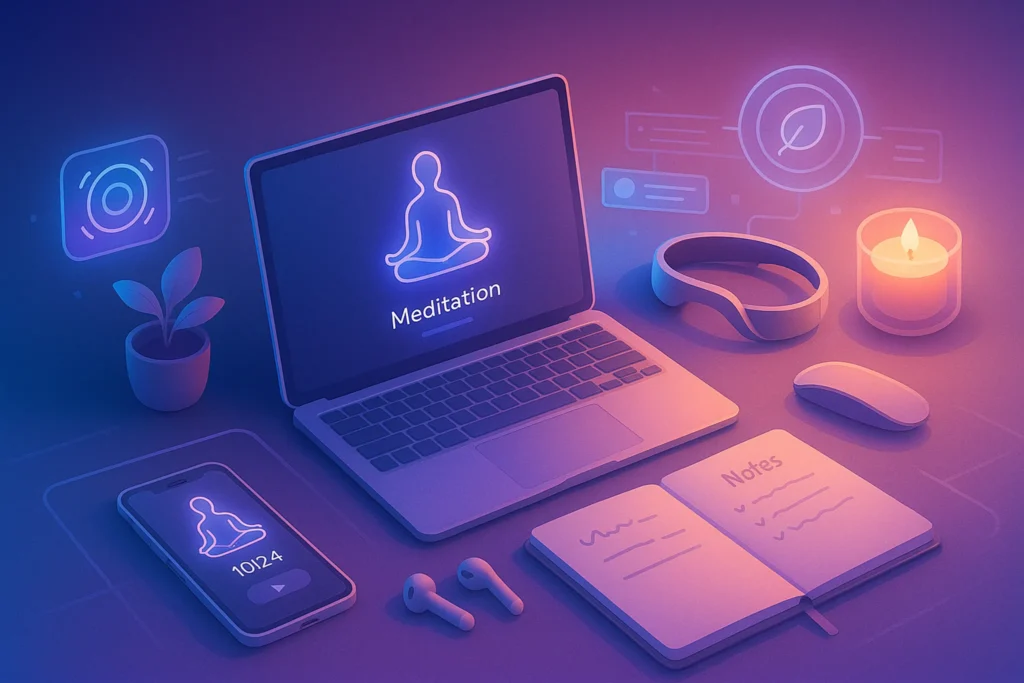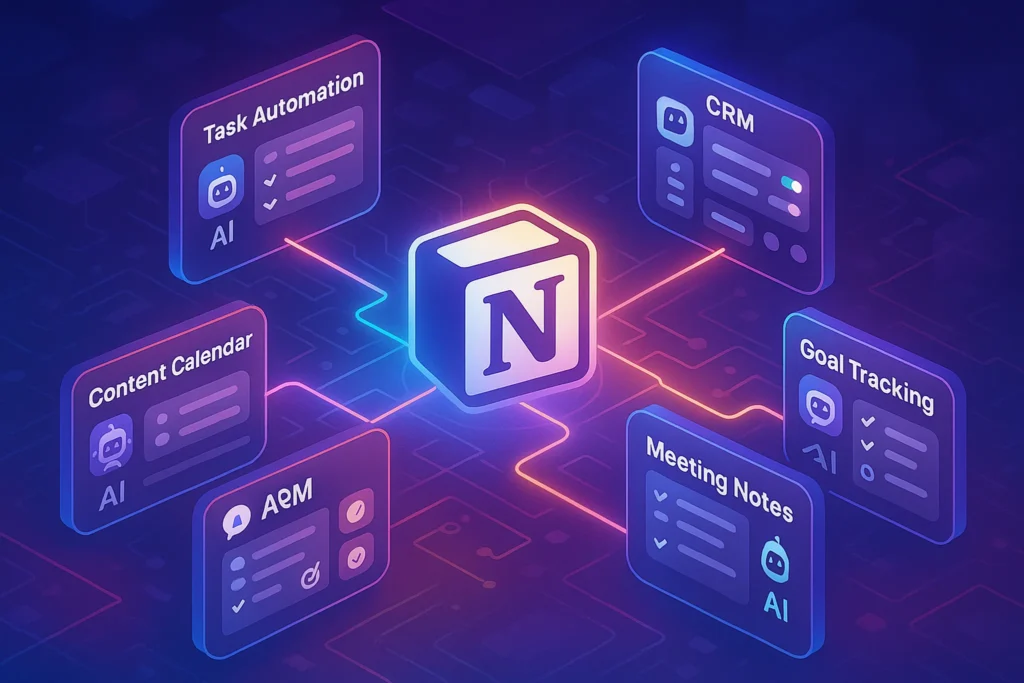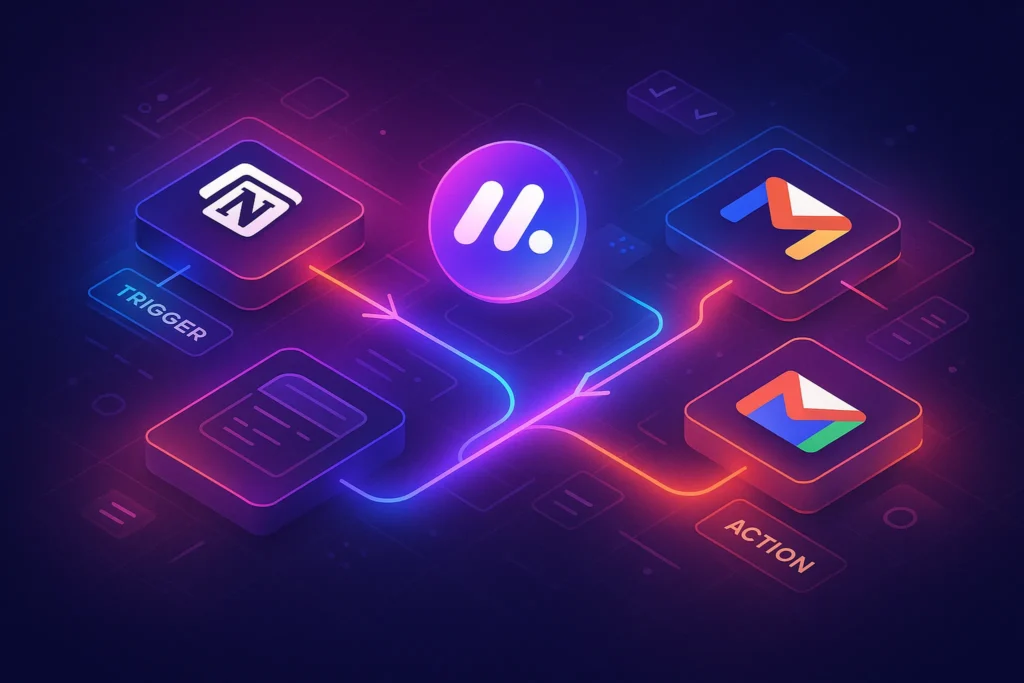-This post may contain affiliate links. If you click on one and make a purchase, I may earn a small commission at no extra cost to you.-
🧭 Introduction
In high-demand work environments—especially remote—stress and context-switching can derail performance. Enter mindfulness tech: a powerful blend of apps and gadgets designed to help you pause, reset, and re-align. In this guide, we review meditation apps supported by empirical research and EEG wearables that provide real-time feedback. You’ll walk away equipped to build a calmer, more focused work routine that seamlessly complements your remote setup as discussed in How to Build a Daily Routine That Actually Sticks.
📱 Meditation & Mindfulness Apps
Ever sit down to work and realize your mind has already wandered through 10 tasks before you even begin? That’s where mindfulness apps step in—not to force calm, but to gently guide you there. Take Headspace: its guided meditations are structured like mini-classes, helping you train your mind to return to focus faster. The “Workday Reset” sequence, for instance, primes your attention before a deep session and offers a short follow-up to prevent midday drift.
Meanwhile, Calm isn’t just about sitting still—it’s a tool for holistic stress recovery. Its background soundscapes mimic forest rain or crackling fireplaces, offering a sensory escape that resets your energy after prolonged screen time. Pairing Calm before wrap-up time can signal to your brain that the workday is turning off.
For a free option that still packs punch, Insight Timer delivers thousands of guided sessions, ranging from 2-minute breath-focus to 30-minute walking meditations. Because it supports silent timers and customizable intervals, Insight Timer is ideal for slotting quick mental resets into Pomodoro sprints or prolonged focus blocks.
Apps like Aura go further—asking how you feel, then delivering a tailored micro-practice. It knows when you’re stressed, tired, or stuck, and suggests just the right minute-long mindfulness technique—no hunting around, no decision fatigue.
🧠 Headspace – Science-Backed Meditation Workflows
Headspace is often considered the gold standard. It offers structured 10-day productivity courses, guided meditations for focus, and live “meditation at work” breaks. Rated 4.8⭐ on the App Store, users report reductions in stress, burnout, and aggressive tendencies due to its habit-building features. For remote workers, Headspace helps carve mini mindfulness rituals between deep work blocks.
🌙 Calm – Relaxation & Sleep Support
Calm doubles as a meditation app and a mental-health-focused sleep tool. With sleep stories, breathing exercises, and backgroundimmersive sessions, it’s perfect after long remote workdays. It reflects a holistic take on stress management across the work-life continuum.
⏰ Insight Timer – Best Free Library
For those on a budget, Insight Timer offers 100,000+ free guided meditations and music tracks. It also supports timer-only silent sessions for micro-break resets—perfect for impromptu mindfulness between meetings or sprints in How to Overcome Procrastination with Technology.
🤖 Aura – Personalized Micro-Practices
Aura stands out for delivering AI-personalized sessions based on your mood and time available. You’re rarely in a deep state but still reset—perfect for distributed workers who need quick midday breaks.
🎧 Gadgets That Enhance Mindfulness
Apps can guide intention, but gadgets make mindfulness tactile and immersive. The Muse 2 EEG headband, for example, tracks your brain’s electrical patterns in real-time. During a session, it responds with soft audio cues—white noise when mind drifts, silence when focus returns—teaching you to proactively recenter attention rather than letting thoughts wander. Over weeks, users often report deeper concentration and reduced frustration in stressful times.
The Muse S takes this further by doubling as a sleep tracker and guided sleep aid. After a busy evening, wearing Muse S can help you unwind, offering your brain measurable data about how quickly you drift into deep sleep or linger in restless neutrality.
If EEG feels too sophisticated, Flowtime is a great entry point. Its lightweight band offers simple meditation coaching with biofeedback—no elaborate setup. It encourages short mental resets, making it an excellent bridge between app meditation and smart wearables.
For those not ready for wearables, even a smart ring (Oura-style) can change perspective. Monitoring heart rate variability (HRV) and sleep quality, it surfaces your physiological stress trends. When you see low HRV one morning, that’s a reminder to add meditation or a mindful break into your workday to reset the trajectory.
Muse 2 EEG Meditation Headband
This wearable measures your brain’s electrical signals and gives real-time white-noise feedback to guide calm. Users report deeper meditations and more consistent practice thanks to objective insights into their focus. It’s rechargeable and compatible with popular meditation apps.
Muse S: Sleep & Meditation Headband
A premium version of Muse designed for both meditation and sleep. It tracks sleep patterns and incorporates guided sessions to enhance rest. Ideal for those battling evening anxiety.
Flowtime Meditation Headband
Flowtime offers EEG-based meditation feedback in a younger, more affordable package. Though less well-known, early reviews highlight a strong focus on mindfulness with lower barrier to entry.
Smart Ring (Oura-style)
While budget-friendly, these smart rings track heart rate variability (HRV) and sleep quality—crucial stress indicators. Staying aware of your physical state helps inform when to pause and breathe.
🧭 How Mindfulness Tech Transforms Your Day
What’s powerful about mindfulness tech isn’t distraction avoidance—it’s emotional calibration. Imagine mid-afternoon tension. Instead of forcing through, you put on a Calm track or press start on Aura. Five minutes later, your system resets; blood pressure drops, the stress cloud lifts, and you’re ready to re-engage with clarity.
EEG feedback tools teach more profound lessons: you learn what calm feels like. If your mind drifts into worry during a meeting, you can recognize that drift by memory and gently return your focus—with or without the gadget.
Smart rings track invisible patterns—like poor sleep after a stressful day. That data nudges you to prioritize rest over late-night screen marathons, reducing burnout. You don’t chase short bursts of focus—you design days where focus becomes more natural.
⏱️ Build Better Micro-Breaks
Integrating Headspace or Aura sessions between focused work blocks resets anxiety levels. Headspace’s breathing meditations complement app combos like Calm or Insight Timer, establishing emotional clarity before jumping back into tasks—a practice also highlighted in tools from How to Overcome Procrastination with Technology.
🎧 Objective Feedback Enhances Practice
Gadgets like Muse detect when your mind drifts, giving audial or visual cues to re-center. This turns intangible experiences into measurable progress—boosting consistency and focus potential.
🧠 Data + Reflection = Reduced Stress
Tracking your HRV or sleep through a smart ring helps identify high-stress patterns. Maybe you’re less productive after long meetings—now data guides you to schedule a meditation or restorative walk instead.
🔗 Integration Tips & Smart Workflow
Integrating mindfulness tech isn’t disruptive—it enhances existing routines. Start your day with a 5-minute Headspace session as your morning anchor (borrowing from How to Build a Daily Routine That Actually Sticks). Schedule Calm sessions during lunch or post-deep-work Pomodoro breaks to prevent energy crash.
For those using focus gadgets or rings: sync your HRV or EEG insights with time-block data. If morning readings highlight stress, add a mini meditation before block one. If evening readings spike yet show poor sleep, add a breathing session before bed.
And keeping everything in sync? Let your mindfulness data feed into your daily planner or Notion dashboard. Seeing meditation, rest, and mood items next to your task list builds a holistic productivity ecosystem—not just task-focused workflow.
-
Use Headspace with morning routines from How to Build a Daily Routine That Actually Sticks: build a 5-minute session into your wake-up flow.
-
During rest blocks from Overcome Procrastination, merge Pomodoro breaks with Calm or Insight Timer meditations to reduce decision fatigue.
-
Let your gadgets influence time-block planning: if your ring data shows higher morning stress, schedule meditation before deep-work blocks.
🧘♀️ Bonus: Best Daily Mindfulness Routine (with Tech)
Not sure how to integrate mindfulness tools into your already-packed day? Here’s a simple, tech-augmented routine to build calm into your workflow—without needing to meditate for hours or overhaul your schedule.
🕗 Morning (7:30 AM)
Wake up and open the Headspace “Focus” meditation or a 3-minute Aura breathing session. If you slept poorly (as flagged by your smart ring), prioritize a longer reset or do a gentle Calm body scan before getting out of bed.
🖥️ Pre‑Work Block (9:00 AM)
Put on your EEG headband (Muse or Flowtime) and start a 5-minute “calm calibration.” This sets your brain state for deep work and helps you identify how your thoughts drift. Pair this with noise-canceling focus playlists for added benefit.
⏸️ Midday Reset (12:30 PM)
After a morning of back-to-back work blocks or virtual meetings, take 7–10 minutes using Insight Timer’s guided breathwork or walking meditation. Let your smart ring remind you if your stress biomarkers spiked during the AM.
🎧 Late Afternoon Recharge (3:30 PM)
If your productivity dips, open Calm’s “Work Break” session or use Aura for a mood-check and fast reset. Flowtime headbands can provide biofeedback that helps re-stabilize your focus before the final sprint.
🌙 Wind Down (9:00 PM)
At day’s end, use the Muse S for a sleep-focused meditation, or simply run a 5-minute gratitude reflection on Insight Timer. Let your wearables passively record sleep quality to improve your next day’s planning.
This routine doesn’t aim for perfection—it simply keeps you mindful, grounded, and aligned.
❌ Common Pitfalls When Using Mindfulness Tech
Mindfulness gadgets and apps are helpful—but only when used mindfully. Here are the most common mistakes to avoid:
📉 Mistake #1: Tech as a Crutch
Using Calm or Headspace during stress spikes is helpful, but over-reliance without understanding underlying causes can create avoidance, not resolution. Pair tech with journaling or therapy when necessary.
🌀 Mistake #2: Gadget Overload
More tools ≠ more peace. Don’t combine too many apps or gadgets at once. Start with one (like Aura or Muse), build a habit, then gradually layer more.
📵 Mistake #3: Ignoring Digital Boundaries
Ironically, using phones for meditation can re-trigger dopamine loops—checking messages, notifications, or getting distracted. Enable Focus Mode or use distraction blockers before sessions to preserve their impact.
📆 Mistake #4: Inconsistency
Skipping daily use breaks the neural benefits of mindfulness. Make it part of your daily routine (see our guide on How to Build a Daily Routine That Actually Sticks) rather than something you only use reactively.
🔮 The Future of Mindfulness Tech
Mindfulness is evolving beyond timers and apps. The next wave of innovation blends AI, biofeedback, and even immersive experiences.
🧬 Real-Time Emotion Recognition
Some tools are integrating emotion-AI—like facial micro-expression readers and speech tone detectors—to personalize mindfulness prompts before stress hits. Think of it as emotional autocorrect.
🌐 Virtual Reality (VR) Meditation Rooms
Apps like Tripp or Maloka create immersive guided meditations in 360° environments. Users can meditate under auroras, inside oceans, or atop mountain ranges—all from their living room.
🪞 AI-Driven Reflection Logs
New tools are combining AI with journaling. Apps like Mindsera and Replika allow you to offload thoughts, then reflect them back as organized insights or action steps—supercharging post-meditation clarity.
🤖 Smart Assistant Integration
Imagine asking Siri or Alexa to “run my focus meditation” and having your EEG headband sync, music play, lighting shift, and breathing routine start—all hands-free. That future is already arriving.
As this tech matures, mindfulness will shift from something we “try to remember” to something seamlessly embedded in our routines.
🧠 Nerd Verdict
Mindfulness tech is not just wellness fluff—it’s stress defense designed for efficiency. Whether you’re tapping Headspace for an energy reset or wearing Muse to sharpen focus, these tools embed calm into your workflow. Pair them with routines, blockers, and reflection, and stress-free productivity becomes less aspirational and more intentional.
❓ FAQ
Q: Can these tools really reduce stress during work?
A: Yes—Headspace is backed by 50+ peer-reviewed studies showing reduced burnout and improved focus . EEG wearables like Muse bring objective mindfulness feedback, dramatically improving practice consistency.
Q: Do I need a gadget or is an app enough?
A: Apps alone—especially Insight Timer and Aura—provide solid mindfulness. Gadgets enhance practice by giving real-time biofeedback, ideal if you’re tracking progress or training mental focus.
Q: Is mindfulness tech expensive?
A: Apps like Insight Timer are free (optional premium). EEG headbands typically range from £180–£330, and smart rings can cost £25+. Choose based on budget, mindfulness frequency, and desired data depth.
💬 Would You Bite?
Which mindfulness tool will you try this week—app-only or gadget-powered?
Drop a comment below, and I’ll share starter templates or setups (Headspace routines, smart ring sync flows) to help you seamlessly integrate it into your remote day.👇



